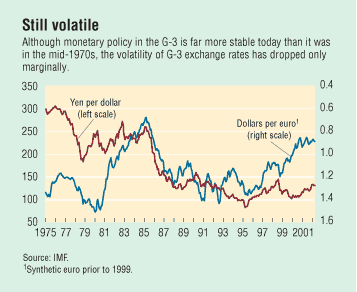 About F&D Subscribe Back Issues Write Us Copyright Information Free Email Notification Receive emails when we post new
items of interest to you. |
Why Are G-3 Exchange Rates So Fickle? Kenneth S. Rogoff
The mystery of the volatility of the world's three key currencies continues, despite leading economist Rudiger Dornbusch's path-breaking insights.
Last November, at the IMF's Second Annual Research Conference, it was my good fortune to be able to pay tribute to the twenty-fifth anniversary of Rudiger Dornbusch's famed "overshooting" model of exchange rates. Dornbusch's 1976 paper became an instant classic because it seemed to make sense of the chaotic new world of flexible exchange rates, which had only just replaced the serene "Bretton Woods" system of fixed rates. In Dornbusch's view, excessive exchange rate volatility was the inevitable result of the chaotic monetary policies that had led to the breakup of fixed rates in the first place. If domestic monetary policies are unpredictable, then so, too, will be domestic inflation differentials. Ergo, the exchange rate must be volatile because, in the very long run, there has to be a tight link between national inflation differentials and exchange rates. (At least, this is what we have all believed since Swedish economist Gustav Cassel championed his theory of "purchasing power parity"—that exchange rates adjust to reflect differences in consumer price levels—as the way to reset world exchange rates after the system broke down during World War I.) If Dornbusch had merely pointed out that monetary policy had lost its way in the 1970s, he would have been regarded as sensible but not necessarily brilliant. The stroke of genius in his paper was "overshooting." According to Dornbusch's now famous logic, monetary policy volatility is not only reflected in exchange rate volatility but is also amplified. The core idea is that the sluggishness of domestic prices and wages forces the exchange rate to be the shock absorber for monetary policy. Dornbusch's theory, which he spiced up by incorporating the exciting new theory of "rational expectations"—when private agents form exchange rate expectations based on reasoned and intelligent examination of available economic data—suggested that modest improvements in monetary stability would be rewarded with large gains in exchange rate stability. The new world of flexible exchange rates was too young in 1976 to provide enough data to meaningfully test what is now often labeled the Mundell-Fleming-Dornbusch model. Nobody really cared. It was a beautiful theory, and Dornbusch's new view of flexible exchange rates reinvigorated the field. Recall the well-worn quip that "an economist is someone who sees something in practice and asks if it is possible in theory." His model gave reassurance that there might be some logic to the apparent randomness of flexible exchange rates, and maybe even a cure for volatility. Students, who had for more than a decade rejected the field of international finance as moribund, flocked to it starting in the mid-1970s. Dornbusch's very difficult and confrontational graduate classes at the Massachusetts Institute of Technology (MIT) were populated by the likes of Lawrence Summers, Paul Krugman, and Jeffrey Sachs. (Indeed, Rudiger Dornbusch's MIT class is the answer to the trivia question: when were these guys last humiliated in public?) This is the happy, fairy-tale part of our story. But it is not the end. Whereas the overshooting model is a landmark theoretical achievement, it is an empirical bust, at least as far as it concerns exchange rates among the United States, Japan, and Europe (known as the Group of Three, or G-3). The most obvious observation is that monetary policy in the G-3 is far more stable today than it was in the mid-1970s after the first oil crisis. Inflation rates have fallen dramatically (albeit too far in Japan's case). The strengthening of central bank independence and the appointment of "conservative" central bankers who target low inflation have served to anchor private sector inflation expectations.  Yet the volatility of G-3 exchange rates has dropped only marginally since the 1970s (see chart). Where is the windfall that we were supposed to reap by restoring global monetary stability? More serious empirical work aimed at formally testing empirical exchange rate models decisively confirms the empirical failure of the overshooting model, at least in explaining short- and medium-run fluctuations. The only consolation, really, is that no other theory seems to work all that well, at least not for G-3 exchange rates. One can do notably better in explaining exchange rates for many smaller countries, although I will leave that to a future column. If Dornbusch's elegant theory is wrong, what can one say about G-3 exchange rates? Fortunately, the glass is not completely empty, even if it is far from half full. Over very long horizons, of two years and more, there is definitely some element of predictability to exchange rates. First, even though Casell's theory of purchasing power parity manifestly fails as a short-run proposition, over the long run, there is some tendency for a country's real exchange rate (the nominal exchange rate adjusted for differences in relative national price levels) to return to its historical value. But the adjustment is very slow indeed. All empirical evidence suggests that one must think in terms of several years, not several months, for the pull of purchasing power parity to kick in. Second, the well-worn so-called Balassa-Samuelson effect also has some bite. Balassa-Samuelson's 1960s analysis predicted that the real exchange rates of fast-growing countries will tend to rise over time, mainly because growth bids up the prices of nontraded goods. The Balassa-Samuelson effect seemed to work for a long time in explaining the trend real appreciation of the yen that started in the 1950s and of the deutsche mark from the 1960s onward. During the 1990s, the Balassa-Samuelson effect probably ran in reverse, given that U.S. growth became stronger than Europe's and much stronger than Japan's. Arguably, Balassa-Samuelson even accounts for 4�5 percent of the trend real appreciation of the dollar against the yen and the euro in the past five to six years. Still, overall, reversion to purchasing power parity and the Balassa-Samuelson effect can explain only a fairly small share of short-term exchange rate volatility. As literally hundreds of studies of G-3 exchange rate volatility have confirmed, the lion's share of short-term exchange rate movements between the euro, the yen, and the dollar defy systematic explanation, much less prediction. The flip side of G-3 exchange rate volatility is that the effects seem to be less insidious than was commonly thought at the time of Dornbusch's writing. The jury is still out, but so far it has proved very hard to systematically show that G-3 exchange rate volatility is as damaging as early critics of flexible exchange rates once argued. One reason, perhaps, is that domestic prices, even of imported goods, seem surprisingly resilient to exchange rate movements. The consensus estimate of the "pass-through" from exchange rates to prices for the United States is only about 50 percent after one year for wholesale prices, even less for consumer prices. Estimates for Europe and Japan are only slightly higher. Indeed, very recent work on the United States suggests that the one-year pass-through may have become even smaller over the past few years, dropping perhaps to 25 percent. Economist Maurice Obstfeld and I have noted the "disconnect" between exchange rates and the real economy. We suggest that part of the explanation may lie in the fact that, even in today's global world, there is still much more trade within borders than across them. As a consequence, even relatively modest shifts in international current account positions can lead to rather large changes in equilibrium exchange rates. The current situation, where global current account imbalances are large and growing across the major regions, is thus especially susceptible to large exchange rate shifts, as we discuss in the IMF's April 2002 World Economic Outlook. Maybe some day we will have a much more convincing model of G-3 exchange rates. I hope to see it!
References: Rudiger Dornbusch, 1976, "Expectations and Exchange Rate Dynamics," Journal of Political Economy, Vol. 84 (August), pp. 1161�76. Richard Meese and Kenneth Rogoff, 1983, "Empirical Exchange Rate Models of the 1970s: Do They Fit Out of Sample?" Journal of International Economics, Vol. 14 (February), pp. 3�24. http://www.economics.harvard.edu/~krogoff/JIE1983.htm Maurice Obstfeld and Kenneth Rogoff, 2000, "The Six Major Puzzles in International Macroeconomics: Is There a Common Cause?" in NBER Macroeconomics Annual 2000, ed. by Ben Bernanke and Kenneth Rogoff (Cambridge, Massachusetts: MIT Press). http://papers.nber.org/papers/W7777 and http://www.economics.harvard.edu/~krogoff/NBER2000.htm Kenneth Rogoff, "Dornbusch's Overshooting Model After Twenty-Five Years," Mundell-Fleming Lecture at the IMF's Second Annual Research Conference, Nov. 29�30, 2001; IMF Working Paper 02/39 of the same title (Washington, 2002). http://0-www-imf-org.library.svsu.edu/external/pubs/cat/longres.cfm?sk=15653.0
|